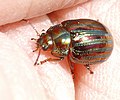
Salvia rosmarinus, commonly known as rosemary, is a shrub with fragrant, evergreen, needle-like leaves and white, pink, purple, or blue flowers, native to the Mediterranean region. Until 2017, it was known by the scientific name Rosmarinus officinalis, now a synonym.
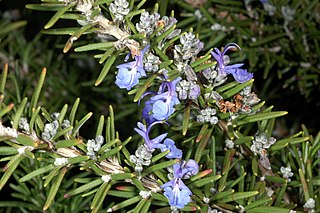
Rosmarinus is a small taxonomic clade of woody, perennial herbs with fragrant evergreen needle-like leaves in the family Lamiaceae, native to the Mediterranean Basin.

The insects of the beetle family Chrysomelidae are commonly known as leaf beetles, and include over 37,000 species in more than 2,500 genera, making up one of the largest and most commonly encountered of all beetle families. Numerous subfamilies are recognized, but the precise taxonomy and systematics are likely to change with ongoing research.

Salvia officinalis, the common sage or sage, is a perennial, evergreen subshrub, with woody stems, grayish leaves, and blue to purplish flowers. It is a member of the mint family Lamiaceae and native to the Mediterranean region, though it has been naturalized in many places throughout the world. It has a long history of medicinal and culinary use, and in modern times it has been used as an ornamental garden plant. The common name "sage" is also used for closely related species and cultivars.
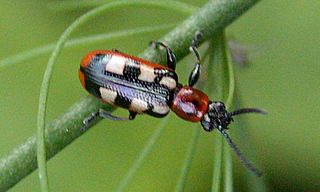
The common asparagus beetle is an important pest of asparagus crops both in Europe and in North America. Asparagus is its only food plant. The beetle is 6.0 mm to 9.5 mm long and slightly elongated. It is metallic blue-black in color with cream or yellow spots on its red-bordered elytra. The larvae are fat gray grubs with dark heads.
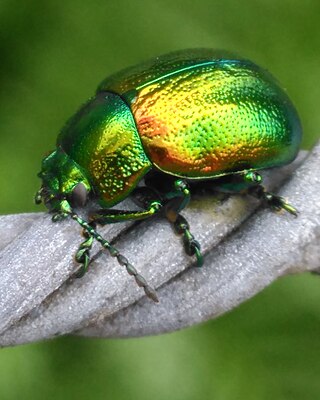
The Tansy beetle is a species of leaf beetle. The common name derives from its main foodplant, Tansy, but it can also use other wetland plants such as Gypsywort and Water Mint. It measures 7.7–10.5 mm in length and has a characteristic bright metallic green colouration, with pitted elytra and a coppery tinge. In addition to the nominotypical subspecies, which repeats the specific name, C. graminis graminis, there are five further distinct subspecies of Tansy beetle, which, collectively, have a Palearctic distribution, although in the majority of countries where it is found the species is declining. In the United Kingdom it is designated as 'Nationally Rare'. The stronghold population here is located along the banks of the river Ouse in York, North Yorkshire. Other, small, fenland populations exist at Woodwalton Fen and at Welney Wildfowl and Wetlands Trust (WWT) reserve.

Rosmarinic acid, named after rosemary, is a polyphenol constituent of many culinary herbs, including rosemary, perilla, sage, mint, and basil.

The Chrysomelinae are a subfamily of leaf beetles (Chrysomelidae), commonly known as broad-bodied leaf beetles or broad-shouldered leaf beetles. It includes some 3,000 species around the world.

Chrysolina cerealis, the rainbow leaf beetle or Snowdon beetle, is a beetle belonging to the family Chrysomelidae.

Xanthogaleruca luteola, commonly known as the elm-leaf beetle, is a beetle species in the family Chrysomelidae that is native to Europe but invasive in other parts of the world.

Salvia is the largest genus of plants in the sage family Lamiaceae, with nearly 1000 species of shrubs, herbaceous perennials, and annuals. Within the Lamiaceae, Salvia is part of the tribe Mentheae within the subfamily Nepetoideae. One of several genera commonly referred to as sage, it includes two widely used herbs, Salvia officinalis and Salvia rosmarinus.

Chrysolina grossa, the red leaf beetle, is a species of broad-shouldered leaf beetles belonging to the family Chrysomelidae, subfamily Chrysomelinae.

Cassida viridis, common name green tortoise beetle, is a species of beetle in the leaf beetle family (Chrysomelidae).

Diabrotica balteata is a species of cucumber beetle in the family Chrysomelidae known commonly as the banded cucumber beetle. It occurs in the Americas, where its distribution extends from the United States to Colombia and Venezuela in South America. It is also present in Cuba. It is a pest of a variety of agricultural crops.

Gratiana boliviana is a species of beetle in the leaf beetle family, Chrysomelidae. Its common name is tropical soda apple leaf beetle. It is native to South America, where its distribution includes Argentina, Brazil, and Paraguay. It specializes on tropical soda apple, an invasive plant species. It has been released as an agent of biological pest control against the weedy plant in Florida and other parts of the United States.

Bruchus is a genus of beetles in the leaf beetle family, Chrysomelidae. They are distributed mainly in the Palearctic, especially in Europe. Several occur in other parts of the world, such as North America, Africa, and Australia, as introduced species. Several species are notorious agricultural pests.

Phratora is a genus of leaf beetles. It is synonymous to Phyllodecta . European Phratora species can be distinguished based on morphology of female genitalia., but they differ little in size and body form and most show metallic coloration.

Chrysolina coerulans, also known as the blue mint beetle or blue mint leaf beetle, is a species of beetle in the family Chrysomelidae. It is in the subgenus of Synerga. It is native to a wide range of countries between mid and eastern Europe and lives alongside rivers and in meadows, it feeds on various plant members of the mint family.
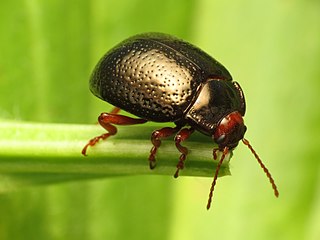
Chrysolina bankii is a species of leaf beetle native to western Europe and the western Mediterranean Basin. It has also been introduced to the US, where its range is expanding.

Systena frontalis, the red-headed flea beetle, is a species of flea beetle in the family Chrysomelidae. It is found in North America. It is named for its red colored head that contrasts its black body. Like other flea beetles, it has powerful saltatorial hind legs specialized for jumping. Like all beetles, this insect is holometabolous The larvae are off white in color, 5-10mm in length, have a sclerotized head capsule and a short posterior protrusion.







